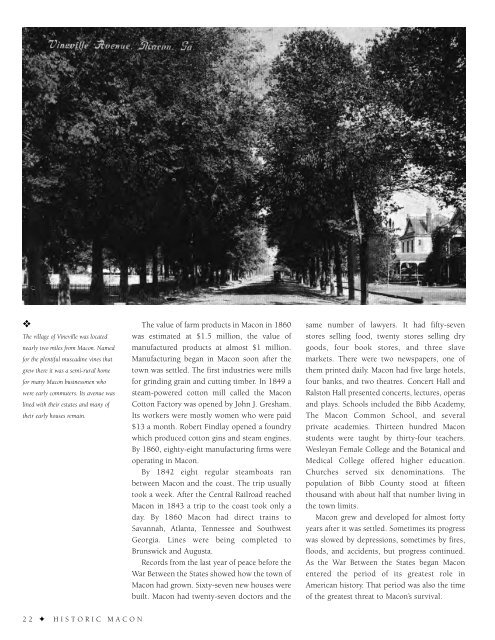Historic Macon
An illustrated history of the city of Macon, paired with the histories of companies, families and organizations that make the region great.
An illustrated history of the city of Macon, paired with the histories of companies, families and organizations that make the region great.
Create successful ePaper yourself
Turn your PDF publications into a flip-book with our unique Google optimized e-Paper software.
❖<br />
The village of Vineville was located<br />
nearly two miles from <strong>Macon</strong>. Named<br />
for the plentiful muscadine vines that<br />
grew there it was a semi-rural home<br />
for many <strong>Macon</strong> businessmen who<br />
were early commuters. Its avenue was<br />
lined with their estates and many of<br />
their early houses remain.<br />
The value of farm products in <strong>Macon</strong> in 1860<br />
was estimated at $1.5 million, the value of<br />
manufactured products at almost $1 million.<br />
Manufacturing began in <strong>Macon</strong> soon after the<br />
town was settled. The first industries were mills<br />
for grinding grain and cutting timber. In 1849 a<br />
steam-powered cotton mill called the <strong>Macon</strong><br />
Cotton Factory was opened by John J. Gresham.<br />
Its workers were mostly women who were paid<br />
$13 a month. Robert Findlay opened a foundry<br />
which produced cotton gins and steam engines.<br />
By 1860, eighty-eight manufacturing firms were<br />
operating in <strong>Macon</strong>.<br />
By 1842 eight regular steamboats ran<br />
between <strong>Macon</strong> and the coast. The trip usually<br />
took a week. After the Central Railroad reached<br />
<strong>Macon</strong> in 1843 a trip to the coast took only a<br />
day. By 1860 <strong>Macon</strong> had direct trains to<br />
Savannah, Atlanta, Tennessee and Southwest<br />
Georgia. Lines were being completed to<br />
Brunswick and Augusta.<br />
Records from the last year of peace before the<br />
War Between the States showed how the town of<br />
<strong>Macon</strong> had grown. Sixty-seven new houses were<br />
built. <strong>Macon</strong> had twenty-seven doctors and the<br />
same number of lawyers. It had fifty-seven<br />
stores selling food, twenty stores selling dry<br />
goods, four book stores, and three slave<br />
markets. There were two newspapers, one of<br />
them printed daily. <strong>Macon</strong> had five large hotels,<br />
four banks, and two theatres. Concert Hall and<br />
Ralston Hall presented concerts, lectures, operas<br />
and plays. Schools included the Bibb Academy,<br />
The <strong>Macon</strong> Common School, and several<br />
private academies. Thirteen hundred <strong>Macon</strong><br />
students were taught by thirty-four teachers.<br />
Wesleyan Female College and the Botanical and<br />
Medical College offered higher education.<br />
Churches served six denominations. The<br />
population of Bibb County stood at fifteen<br />
thousand with about half that number living in<br />
the town limits.<br />
<strong>Macon</strong> grew and developed for almost forty<br />
years after it was settled. Sometimes its progress<br />
was slowed by depressions, sometimes by fires,<br />
floods, and accidents, but progress continued.<br />
As the War Between the States began <strong>Macon</strong><br />
entered the period of its greatest role in<br />
American history. That period was also the time<br />
of the greatest threat to <strong>Macon</strong>’s survival.<br />
22 ✦ HISTORIC MACON
















